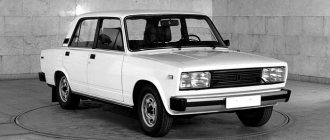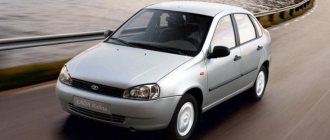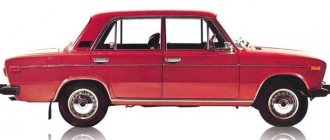In 1997, the extremely successful line of Lada Samara models was replenished with a new series, codenamed Samara 2. One of the first models of the updated family was the VAZ 2115, which attracted potential buyers with reduced fuel consumption per 100 km, improved appearance, and a more comfortable interior than its predecessors. without unnecessary glamor. The car turned out to be so popular that it was produced until 2012, enjoying stable demand. Among its advantages are noted:
- Updated design that compares favorably with previous models.
- Improved optics.
- Expanded range of gasoline engines.
- High reliability and maintainability.
- Installation of a modern fuel supply system.
- Reliable suspension, adapted to domestic roads.
Specifications
This is an improved model of the well-known VAZ 21099. The sedan that replaced it has become more popular than its predecessor. It features a number of positive innovations, which include a more modern assembly, economy, and the necessary comfort for the driver.
In Samara, the front optics have been modernized, the design has become streamlined and modern, and the stylish updated trunk lid attracts the attention of many consumers. The modified sedan can be equipped with electric windows, fog lights or heated seats. The on-board computer has become a classic feature for this car.
Advantages of the machine
For more than ten years, developers of modern cars have been resorting to a new type of fuel supply. Outdated carburetors have been replaced by injectors that increase engine efficiency. At the same time, they significantly reduce the flow of fuel into the tank, which significantly saves fuel consumption.
VAZ has such capabilities, which positions itself as a reliable, economical sedan modification vehicle. The fuel consumption of the VAZ 15 per 100 km is significantly less than that of other cars of a similar pricing policy.
Speed sensor
Also, the cause of high fuel consumption per 100 km (VAZ-2114) may be the speed sensor. Its main task is to transmit information about the speed of the vehicle to the control unit. The latter monitors the operation of the engine by adjusting the throttle valve. The problem with this sensor will be shown by the on-board computer or error reading device. It is almost impossible to replace it yourself without specialized knowledge. Typical symptoms of speed sensor failure:
- Speedometer failure or interruptions.
- “Floating” idle speed.
- Noticeable loss of traction.
- Stopping the engine when idling.
- Increased gasoline consumption.
Car fuel consumption standards
Official data
Gasoline consumption indicators according to technical data sheet
:
- The fuel consumption rate for a VAZ 2115 (injector) on the highway will be 6 liters.
- In the city, the consumption indicator will indicate 10.4 liters.
- In areas with mixed roads – 7.6 liters.
Real gasoline consumption data
Flow data in cold weather
:
- Gasoline consumption in winter on a Lada 2115 will be up to 8 liters on the highway.
- Within the city limits you will have to spend 10.3 liters.
- The mixed view of the road will show the fuel consumption of a 9 liter VAZ.
- Off-road in winter, the car will consume 12 liters.
Actual gasoline consumption of VAZ in summer
:
- In summer, on the highway you will need 6.5 liters with a mileage of 100 km.
- The fuel consumption of the car in the urban cycle is 9.9 liters.
- With a mixed route, fuel consumption will correspond to 8.3 liters.
- In off-road conditions, VAZ 2115 gasoline consumption per 100 km increases to 10.8 liters.
These are good data that determine the economy of a domestically produced car and show its advantage over some foreign cars.
VAZ 2131
This car is better known as Niva 2131. Initially, such cars, built on the basis of the Niva 2121, but with a longer body, were intended for export. But due to their good cross-country ability and relatively low price, they have gained popularity in the domestic market. Production of the VAZ 2131 started in 1993 and continued until 2016, when it was replaced by a newer version, the Lada 4×4 Urban. The VAZ 2131 was equipped with one of five gasoline engines or a diesel power unit.
| Engine | Consumption (city) | Consumption (highway) | Flow (mixed) | Type of fuel |
| 1.7 MT 79 hp | 13.7 | 9.8 | 12.0 | Petrol |
| 1.7 MT 80 hp | 13.7 | 9.8 | 12.0 | |
| 1.7 MT 83 hp | 13.7 | 9.8 | 12.0 | |
| 1.8 MT 82 hp | 13.8 | 12.0 | 13.2 | |
| 1.8 MT 84 hp | 13.8 | 12.0 | 13.2 | |
| 1.9 MT 50 hp | 9.7 | 6.8 | 7.6 | Diesel |
The actual fuel consumption of VAZ models per 100 km may differ from the standard data specified in the tables, and it can only be determined experimentally
It is important to remember that average fuel consumption can differ significantly in winter and summer. If fuel consumption is much higher than the average values given in the tables, the car must be taken to a service station with mechanics and, after determining all the factors of increased consumption, it may be worth converting it to gas
Causes of excessive fuel consumption in Lads
Over time, each vehicle can increase its fuel consumption, which can be due to various factors. The main reason is engine wear or clogged spark plugs. Proper care of your vehicle will bring you pleasure from high-quality, safe and economical driving for many years.
It is necessary to strictly monitor the fuel injectors, fuel pump and fuel filter, which primarily suffer during long-term operation and lead to high fuel consumption.
According to the passport, the fuel consumption of the VAZ Samara-2 car is 7.6 liters in mixed mode, in the city - no more than 9. If such indicators have increased, then the car owner needs to determine the cause and eliminate it.
A car with an injector and built-in computer technology can easily be tuned, which gives it a more modern look, aesthetic beauty, and more comfortable operation. The above indicators of gasoline costs according to real data and according to the technical data sheet do not have significant differences
. It all depends on the care of the car, parking location, and weather conditions.
Despite the fact that the production of this car has already ended, you can see many happy VAZ owners on the roads, which indicates its reliability, high wear resistance, economy in maintenance and fuel consumption. The plant in Togliatti, where the car was produced, has been famous for many years for the high quality of the vehicles produced, which are optimally suited to the conditions of use in our region.
Car tuning
When talking about car tuning, you should take into account many of the subtleties that arise during such an interesting process. When tuning a VAZ-211440, the spare parts for which are not very expensive, you need to remember about the standards that require approval from competent persons. Before you start improving your car, you need to contact the traffic police, providing them with a statement stating the planned changes to the design of the car. This is a mandatory item, neglecting which can result in a hefty fine. Next, officials issue a permit containing conditions for the execution and procedure for issuing a document confirming the technical safety of the car. If global changes are planned, an assessment by specialists is required, as well as attached technical documentation.
Upon completion of the technical work, the owner of the car must provide another application, which must indicate all the changes made, their scale and quality. Then the owner of the car sends it for technical inspection, after which the data is recorded in the registration documents. As you can see, there is a lot of work.
VAZ 2115 – fuel consumption data
In 1997, the extremely successful line of Lada Samara models was replenished with a new series, codenamed Samara 2. One of the first models of the updated family was the VAZ 2115, which attracted potential buyers with reduced fuel consumption per 100 km, improved appearance, and a more comfortable interior than its predecessors. without unnecessary glamor. The car turned out to be so popular that it was produced until 2012, enjoying stable demand. Among its advantages are noted:
- Updated design that compares favorably with previous models.
- Improved optics.
- Expanded range of gasoline engines.
- High reliability and maintainability.
- Installation of a modern fuel supply system.
- Reliable suspension, adapted to domestic roads.
REAL PETROL CONSUMPTION ON VAZ MODELS
Real fuel consumption on the VAZ 2114 (as well as on the VAZ 2113 and 2115) often differs from the factory values. Mainly differs in the direction of increase. Of course, a lot depends on weather conditions. In winter, due to long and frequent warm-ups of the car, gasoline consumption increases, and other factors also influence fuel consumption:
- Driving style. Driving with sudden acceleration and high speed does not save fuel;
- Various malfunctions: in the engine, in the ignition system, in the fuel system, etc.;
- Unregulated tire pressure;
- Driving on a cold engine;
- Fuel quality.
It is necessary to take into account that the fuel consumption of the VAZ 2115 (2113) is practically no different from the gasoline consumption of the 2114 model, since the cars have very similar characteristics and are equipped with exactly the same engines.
Engine 1.3
The modification with the 1.3 engine has been produced since 1997 in limited editions. This is a structurally complex power unit with a rotary cylinder arrangement configured for maximum efficiency, producing 135 forces. With it, the car accelerates to hundreds in 9 seconds and a top speed of 190 kilometers per hour. The fuel consumption of the VAZ 2115 in this configuration is:
- in the city 12.5 l;
- in mixed mode 10 l;
- on the highway 7.5 liters.
Owner reviews
- Alexander, Vyborg. My brother gave me his 2003 VAZ 2115 with a 1.3 engine with 135 horsepower. Pleasantly smooth ride, starts off very quickly, although you need to strictly monitor the engine. The fuel consumption is confusing compared to other versions; all around it’s about 12 liters per hundred, which is more than the classic. But speed comes at a price.
- Denis, Saratov. I bought 2115 in 2009, used, with a mileage of 150 thousand km. The car drives very well, to make it more comfortable, I installed an air conditioner, but gasoline consumption has become frightening - in the city in the heat it turns out to be up to 13 liters, I fill it with AI 92.
- Alexey, Kotelnikovo. I have a VAZ 2115 produced in 2002 in an interesting modification with a 1.3 engine with 135 horsepower. My opinion is that the car has an ill-conceived gearbox, and therefore cannot reveal its full potential. With good dynamics, consumption is 14 liters, I’m thinking of changing it to something more economical.
Second generation
Since 2013, the Lada Kalina car line has been updated and new cars have entered the market. Among them was not the usual sedan, with which the series began production, but the production of 5-door hatchbacks and station wagons continued. Fuel consumption on the new Lada Kalina has been reduced, but the manufacturer's requests do not always correspond to customer reviews.
The second Kalina came with two types of engines, each with a volume of 1.6 liters, but their power differed. There was also a choice of transmission options; as before, it was possible to purchase a car with a manual 5-speed gearbox or with a 4-speed automatic. A new feature was the entry into the arena of a 5-speed robotic transmission.
The power units installed on the Lada Kalina 2 had the following fuel consumption:
- VAZ-21126 - 98-horsepower engine, 1.6 liter capacity. with four cylinders and 16 valves, it was equipped with a distributed fuel injection system. Gasoline consumption figures in the city are 9.9 liters, on the highway 6.5 liters.
- VAZ-21127 - had 106 hp at its disposal. And fuel consumption on a free road was 5.8 liters, in urban driving it was 8.4 liters. Gasoline was also supplied by distributed injection.
Owners about consumption on Kalina 2
- Peter, Tyumen. I bought a Lada Kalina Cross in 2015. This is one of the few representatives of the domestic automobile industry with horsepower exceeding one hundred. And indeed the car turned out to be lively; my hatchback can compete with some foreign cars when driving on open sections of the road. The other side of the coin is gasoline consumption in the city; I did not observe the promised 8.4 liters both during the run-in and after it. This engine consumes at least 10 liters per 100 km of road with traffic jams.
- Lev, Voronezh. My wife does not know how to use a manual transmission, so I had to buy a car with an automatic transmission system. The choice fell on the second generation Lada Kalina 2014. Naturally, I understood that, as with any automatic, fuel consumption would be higher than with a manual, and that’s what happened. My figures in the city, judging by the on-board computer data, are usually within the range of 11-12.5 liters per 100 km of traffic. This sad moment worsened three years after the purchase, the injector with nozzles became clogged, for some reason this happens more often on the 8-valve Kalina than on other engines.
- Taras. Moscow. I never regretted buying Kalina Cross for my baby; she often helped me out in situations when more expensive foreign cars failed. And when breakdowns happened, and this happens, the repairs did not cost me much at all. Of course, it cannot be considered a plus that the Lada Kalina has fuel consumption per 100 km, with a power of 106 hp. higher than foreign cars of the same class. In my case, in the city, I fill at the rate of 12 liters, but on the highway the situation changes dramatically and costs drop to 7.5 liters.
- Ilya, Odessa. For a car with such a price, many disadvantages are forgiven, but they exist. First of all, this is the fuel consumption of the Kalina; it can sometimes be compared with the performance of some SUVs. Regular failure of components and parts is also somewhat annoying, but the main thing for me is road noise. Compared to foreign cars, you feel as if you are driving without doors. Of course, there are also advantages: it is inexpensive to service and parts are always easily accessible.
- Andrey, Nakhabino. I don’t understand why people have so much hatred for the Lada Kalina, because you can find out everything about it before buying, and there are plenty of disadvantages, but there are also advantages. Mostly they complain about high gasoline consumption, but you can always install LPG and save money. The metal on the body is good and thick, its quality cannot be compared with Chinese tins. It’s just a pity that the quality of the factory paint is rather weak, and over the years bubbles appear in some places.
Engine 1.5 with injector
In the same 1997, a version of the VAZ 2115 was offered with a 1.5 engine with an injector, which made it possible to obtain a power of 78 horsepower. With it, the car accelerates to the first hundred in 13.3 seconds and a maximum speed of 155 km/h, and it is this modification that has become the most widespread, combining reasonable price and quality. The car is fueled with AI 92 and consumes about a hundred:
- in the urban cycle 8.9 l;
- average 7.8 l;
- on the highway 5.7 liters.
Reviews from VAZ Lada 2115 owners
- Vladimir, Novocherkassk. I have a VAZ 2115 produced in 2007 with an eight-valve 1.5 MT. The main advantage of this car is its amazing reliability. The dynamics, of course, are mediocre, but in mixed mode, even in winter, fuel consumption does not exceed 9 liters per hundred, which completely suits me.
- Nikolay, Tver. Lada 2115 with a 1.5 engine with 78 horsepower is an excellent budget car. Compared to other cars, repairs cost a penny, it handles excellently, and in the city it confidently stays in traffic. Comfort is not enough, but I'm ready for it. To reduce heating in winter, I bought a car blanket, now the car takes 8.5-9 liters per 100 kilometers.
- Ivan, Petersburg. VAZ Lada 2115 with injection 1.5 MT, drove 200 thousand km. The car drives briskly, both in the city and on the highway. The interior is spartan, but enough for me. Fuel consumption on the highway is 6 liters, in the city it reaches 10.
Trouble the engine... Engine 16 model 21126
Oil is supplied to the main and connecting rod bearings, as well as to the camshaft supports under pressure; the cylinders, pistons, pins and rings, camshaft cams and pushers are lubricated by splashing; all other associated parts are lubricated by gravity. Removing the gas tank is carried out using a standard set of tools: wrenches of different sizes, a screwdriver and a hammer in case any element is difficult to dismantle.
| Volume | Transfers | Gasoline consumption by road type |
| Mixed | ||
| 1.5 | Mechanics | 7.8 |
| 1.5 | Mechanics | 7.6 |
| 1.6 | Mechanics | 7.6 |
Engine 1.6 with injector
A modification with a 1.6 engine equipped with an injector produces 80 horses and accelerates the car to hundreds in 13 seconds. The maximum speed of the car is 160 kilometers per hour. The engine is fueled with AI 92 gasoline, the fuel consumption indicator for the VAZ 2115 in this configuration is:
- on a busy road 10.1 l;
- mixed mode 7.6 l;
- on a free road 5.7 liters.
Real gasoline consumption of VAZ 2115
- Peter, Ekaterinburg. For several years I have owned a VAZ 2115 1.6 with 80 horsepower. When accelerating to 150 km/h, the car holds normally, although there is a slight vibration in the steering wheel. True, consumption rises to 14 liters. At a cruising speed of 100-110 km/h, you can comfortably fit in 7 liters, and in traffic - 10.
- Yuri, Moscow. My first car, with their 90s design, I really like it. I have already driven 120 thousand km, during all this time the VAZ 2115 even broke down, the repair cost a penny. The 1.6 engine pulls briskly both at intersections and on the highway. If a new generation of the car were released, I would definitely buy it. Fuel consumption is 10 liters in mixed mode.
- Mikhail, Stavropol. I bought a Lada 2115 secondhand in 2010, although it was in good condition. After a light repair, I haven’t had any problems for many years, only consumables are changed. I like the 1.6 engine, which pulls well in any speed range. Fuel consumption is 9 liters per 100 kilometers.
Is it possible to reduce consumption
If the owner wants to bring gasoline consumption to values close to factory parameters, then it is necessary:
- When accelerating, gently press the accelerator pedal, monitoring instantaneous fuel consumption using the on-board computer.
- Change to a higher or lower gear in a timely manner, avoiding the engine operating at an increased speed or with overload.
- Use the vehicle's inertia and engine braking mode.
- Remove any foreign elements from the car body that were not provided by the factory (for example, a shield on the edge of the hood or deflectors along the upper edge of the glass in the doors).
- Before starting a trip, check the tire pressure, and then bring the parameter to the factory recommended values.
- Carry out periodic maintenance to assess the condition of wheel bearings and brake mechanisms. Jamming of the pads leads to increased fuel consumption, overheating of the wheel hub and impaired vehicle controllability.
To reduce fuel consumption, the driver needs to switch to driving mode in overdrive 5th gear at a speed of up to 60 km/h. This technique allows you to consume 3.9-4.0 liters of fuel (according to the on-board computer) and is used if necessary to get to a gas station. Increasing the speed to 80-90 km/h increases consumption on the highway to 5.5 liters (there are 2 people and a load weighing 30-40 kg in the car).
Reasons for high fuel consumption
Most owners note that the gasoline consumption of the car corresponds to the passport data. Sometimes you can come across complaints that the VAZ 2115 has too much fuel consumption, which differs significantly from that indicated in the technical documentation. Experience shows that the increase in the machine’s appetite is explained by specific reasons, among which experts identify:
- Engine condition. It is recommended to undergo maintenance every 10 thousand km with mandatory diagnostics. A drop in compression leads to significant excess fuel consumption.
- Regular cleaning of the fuel supply system. It is better to do this using professional equipment.
- Timely replacement of fuel, air, oil filters.
- Fuel consumption is significantly increased by a faulty chassis and problems with the transmission.
- Low or high tire pressure leads to increased gasoline consumption; in the cold season it is necessary to “change your shoes” to winter tires, this will help save fuel and make driving safer.
- The increase in consumption is influenced by driving style; to reduce it, you do not need to accelerate and brake too actively, keep the engine in the range of 2000-3000 rpm.
How to understand the need for an oil change
Removing the gas tank is carried out using a standard set of tools: wrenches of different sizes, a screwdriver and a hammer in case any element is difficult to dismantle. Signs of its malfunction, in addition to increased fuel consumption, may be a decrease in power, the engine stalls at idle, and the percentage of harmful impurities in the exhaust gases is exceeded.
VAZ-2115 1.6 (injector) - fuel consumption per 100 km
- City cycle: 10.1 l
- Extra-urban cycle: 5.7 l
- Combined cycle: 7.6 l
The VAZ-2115 is a front-wheel drive sedan, the first representative of the updated Samara family of cars. The Pilot Industrial Production began assembling it in 1997, and starting in 2001 they began assembling it on the factory assembly line. The Samara-2 family is a modernization of the VAZ 2108, 2109 and 21099 models.
The car is excellent, playful and made just for our roads. Among the advantages, we should highlight comfort for the driver and passengers, a large spacious trunk, and excellent dynamics. The ideal combination of price and quality. When choosing spare parts, you can consider different options from manufacturers and choose the best ones in terms of cost. It all depends on the flight of your imagination. “Fifteen” will accept everything without complaint with adequate dedication, and will not let you down under any circumstances. You can fix most of the breakdowns yourself.
It is also necessary to note the strong suspension, which is important on our roads. Excellent stability in any weather, including rainy and icy conditions. The car is economical: on the highway, fuel consumption is 5.5-5.7 liters per 100 km at a speed of 120 km/h. Very comfortable seats, drive 500 km or more and not feel any back pain or unpleasant tingling and numbness.
The car passed all the tests of car owners: “she pulled a trailer, carried a trunk on the roof, she had to stand in the river for almost a day, and it’s okay: she ran as if nothing had happened, however, after the water she had to dry it thoroughly and replace the controller, after which she started up easily and naturally.”
VAZ 2115 fuel consumption reviews
As part of the renewal of the LADA Samara family, the Volzhsky Automobile Plant released the VAZ-2115 in 2000 as a replacement for the popular VAZ-21099 sedan. The model received a completely new front end with new optics, a roof of a different design, new front fenders, an improved interior and more reliable electrical equipment. In 2008, the VAZ-2115 underwent a small facelift to “refresh” the appearance of the car.
Production of this model was completely discontinued in 2012 - it was replaced by the more modern LADA Granta.










